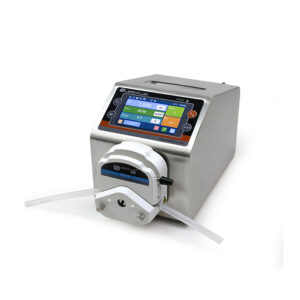Selecting the optimal peristaltic pump speed for a specific application is essential to ensure that the desired flow rate, dosing accuracy, and overall performance are achieved.
Several factors should be considered when determining the appropriate pump speed:
- Required Flow Rate: The desired flow rate for the application is a crucial factor. Determine the specific volume or rate at which the fluid needs to be dispensed or transferred. Pump speed should be adjusted to achieve this flow rate.
- Fluid Viscosity: The viscosity of the fluid being pumped affects the flow rate. Higher viscosity fluids may require a slower pump speed to ensure adequate flow, while lower viscosity fluids can be pumped at higher speeds.
- Tubing Size: The inner diameter of the tubing used in the peristaltic pump head influences the flow rate. Larger tubing diameters allow for higher flow rates, while smaller diameters reduce flow. Select tubing with the appropriate diameter to match the desired flow rate.
- Tubing Material: The choice of tubing material should consider its resistance to chemical interactions with the fluid, temperature resistance, and compatibility. Different tubing materials can affect the flow rate and dosing accuracy.
- Dosing Accuracy: Applications that require precise dosing and metering may need to balance flow rate with dosing accuracy. Slower pump speeds can provide finer control and better dosing accuracy.
- Fluid Compatibility: Ensure that the pump speed is suitable for the specific fluid being pumped. Some fluids may require gentler pumping at lower speeds to prevent shearing, foaming, or other adverse effects.
- Pressure Requirements: Consider the pressure needed to move the fluid through the system. Higher pressure requirements may necessitate slower pump speeds to maintain control and prevent damage to the tubing.
- Environmental Conditions: The temperature and environmental conditions of the application can impact the pump’s performance. Choose a pump speed that accommodates the environmental factors and temperature requirements of the fluid.
- Dead Volume Considerations: Peristaltic pumps have minimal dead volume, meaning that nearly all of the fluid in the tubing is dispensed. This reduces waste and ensures accurate dosing, but it should be considered when determining the flow rate.
- Safety and Contamination Risks: Some applications may require slower pump speeds to minimize the risk of splashing, contamination, or safety hazards associated with faster flow rates.
- Maintenance and Tubing Life: Pump speed can affect the wear and tear on the tubing, potentially affecting maintenance frequency and tubing replacement costs. Slower speeds may extend tubing life.
- Automation and Control System: Determine whether the application requires manual control or automated control of the pump speed. China Peristaltic Pump Speed suppliers Advanced systems can use feedback control to maintain the desired flow rate.
- Regulatory and Compliance Requirements: Consider any industry-specific regulations or standards that may dictate the appropriate pump speed for safety, quality, or compliance reasons.
Selecting the optimal peristaltic pump speed requires a careful balance of these factors, taking into account the specific needs and requirements of the application. It may involve adjusting pump speed during the setup and optimization phase to achieve the desired performance. Monitoring and fine-tuning the pump speed as needed are essential for maintaining accurate and efficient fluid handling.
Are there any safety considerations or limitations associated with peristaltic pump speed adjustments?
Yes, there are safety considerations and limitations associated with peristaltic pump speed adjustments, and it’s important to be aware of them when working with peristaltic pump systems. Some of these considerations and limitations include:
- Tubing Integrity: Excessive pump speed can cause rapid wear and tear on the tubing, potentially leading to tubing failure or rupture. This can result in fluid leakage and contamination. To prevent this, it’s important to monitor the condition of the tubing and replace it as needed.
- Shearing and Foaming: High pump speeds, especially with certain fluids like biological or shear-sensitive materials, can lead to shearing or foaming. This can affect the integrity and properties of the fluid. Slower speeds may be required for such applications.
- Suction Ability: Very low pump speeds may affect the pump’s ability to create sufficient suction to draw in the fluid effectively, especially when dealing with highly viscous materials. Finding the right balance between flow rate and tubing longevity is important.
- Chemical Compatibility: Some fluids may have limitations regarding pump speed. Rapid fluid movement can generate heat due to friction, potentially causing temperature-related issues with certain chemicals or solvents.
- Contamination Risks: Faster pump speeds can increase the risk of fluid splashing, aerosol formation, or spray, potentially leading to contamination or exposure to hazardous materials. Proper safety measures and containment systems should be in place for applications with such risks.
- Tubing Material and Tubing Life: The choice of tubing material and tubing life can affect the pump speed. Some materials are better suited to higher pump speeds and may have longer life, while others may require slower speeds and have shorter tubing life.
- Pressure Buildup: High pump speeds may lead to pressure buildup in the tubing or system. Ensure that the system can handle the pressure generated without risking leaks or damage.
- Maintenance: Slower pump speeds may extend the maintenance intervals and reduce the frequency of tubing replacements, making them a practical choice for applications with a focus on reduced maintenance.
- Automation and Control Systems: Automated control systems can provide safety by ensuring that the pump operates within safe limits. Safety interlocks and alarms can be programmed to respond to any abnormal conditions.
- Regulatory Compliance: Some applications may have regulatory requirements that dictate the permissible pump speeds for safety, quality, or compliance reasons. Complying with these regulations is essential.
To ensure the safe and effective operation of peristaltic pump systems, it’s important to carefully consider these factors, conduct regular maintenance, and adhere to safety protocols specific to the application. Additionally, users should be well-informed about the limitations and guidelines provided by the manufacturer of the peristaltic pump and any industry-specific safety standards.
